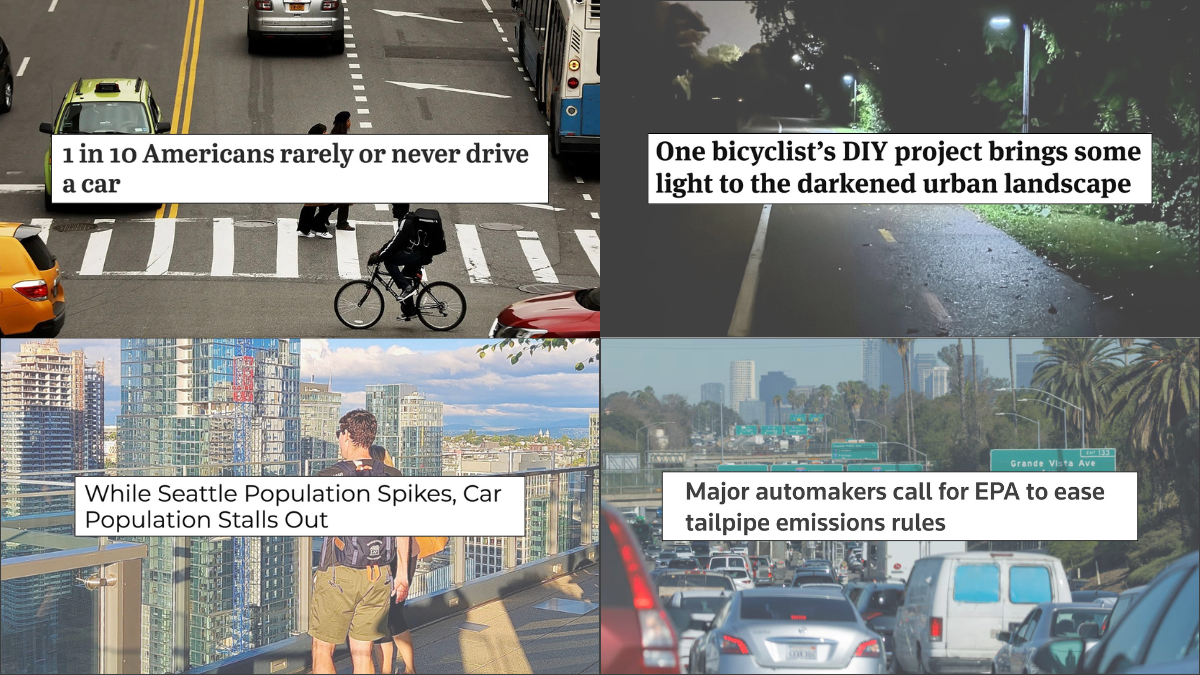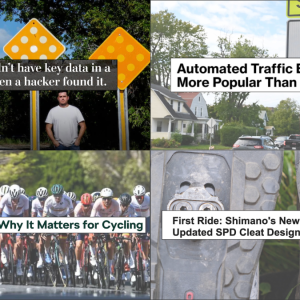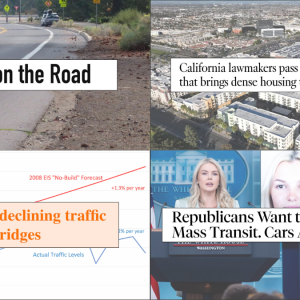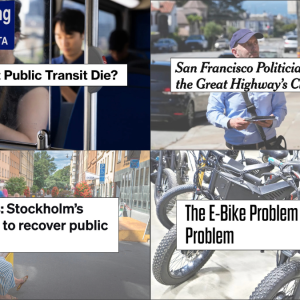Hi friends. Welcome to the week. I hope everyone is doing okay amid talk of federal troops and the latest onslaught of unhinged behavior from Trump and his cronies. Meanwhile, we have a city to run and work to do. Let’s get right to it by making sure we’re up to date with the most notable stories and other content from around the web in the past week.
Who doesn’t drive? Making the rare exception of sharing an older story (November 2024) because it’s important and this is the first day of Week Without Driving. Bookmark this one: 1 in 10 Americans are nondrivers, and people who live in cities, have lower incomes, and/or who are Black are even more likely to be in that group. (Pew Research Center)
More no car news: “Between 2017 and 2023, Seattle added 35,000 households, but just 3,300 cars, new Census data has revealed — in news that is music to urbanist ears.” (The Urbanist)
DIY path lighting: A cyclist in Minnesota was frustrated about lack of lighting on his local bike path, so he bought lights, grabbed a ladder, and hung some up himself. (Minn Post)
Journalistic malpractice: Not only is “defensive walking” a completely off-base and tone-deaf framing for a story about road safety, but there’s no mention that the advocate source of the entire piece (National Safety Council) heads a nonprofit with major funding from several auto companies. Do better NPR!!! (NPR)
‘Israel’ a toxic term in cycling: A billionaire who sponsors a World Tour cycling team acknowledges that his “Israel Premier Tech” team should drop “Israel” from its name next season due to intense pressure from fans, protestors, and other sponsors. (BBC)
Politics in the peloton: American pro cyclist Chloe Dygert weighed into the Charlie Kirk assassination with a sticker on her bike at World Championships that read, “I stand for the truth. I stand with Charlie Kirk.” (Cycling Weekly)
My two favorite things, together: I’ve loved following former basketball star Reggie Miller’s journey into bike racing (my brother has even raced with him down in So Cal), so it’s cool to see him get his due with a full major profile piece. (LA Times)
To EV or not EV: Interesting fight brewing in the auto industry as the largest lobby group for automakers asks Trump to ease emissions standards and rules they say force them to make (allegedly more expensive) EVs, while Tesla begs Trump to keep the rules in place. (Reuters and Reuters)
Thanks to everyone who sent in links this week. The Monday Roundup is a community effort, so please feel free to send us any great stories you come across.







Thanks for reading.
BikePortland has served this community with independent community journalism since 2005. We rely on subscriptions from readers like you to survive. Your financial support is vital in keeping this valuable resource alive and well.
Please subscribe today to strengthen and expand our work.
I think it’s crystal clear that the USA is going to “not EV”.
After all, even in Oregon EV adoption has been a failure with the state only registering ~30% of its 2025 “zero” emission vehicle registration goals.
That’s not clear to me at all — the transition is inevitable, even if we lag the world a bit. If the USA is the only market for gasoline cars, innovation is going to stall while EVs continue to advance. And Trump isn’t going to be in office forever — will his successors continue with what is an objectively bad policy?
EVs are coming, one way or another.
The best projections I’ve seen put us at 50% of the US fleet being electric by 2050.
The only real way to avoid the worst consequences of climate change would be WWII levels of individual sacrifice and a dramatic, immediate reuction in VMT.
Human beings in general and Americans in particular are not capable of sacrificing today for tomorrow, so we’re heading for the worst case scenario on this – unabated CO2 production for decades to come and a huge amount of inertia in the heat engine that is our climate that will be impossible to overcome.
Watts will never admit this but many ‘murricans will be driving gasoline-guzzling mega-SUVs* for decades to come. ‘murrican culture is unique in its resistance to doing the right thing until it has exhausted all alternatives. In the case of ongoing ecocide, waiting until alternatives are exhausted is an incredibly grim future for today’s young people.
*maga-SUVs?
Talking to two friends each with newer plug-in hybrids, I think there’s a lot of merit to going that route for urban dwellers who want a car (as opposed to long-range full EVs).
If they mostly stay in town, they rarely engage the engine and can get over 1500 miles on the small tank. So they have a mostly electric means of travel with no “range anxiety”, it’s easier to charge at home, and its battery required far fewer expensive-to-extract minerals to manufacture.
People with plug-in hybrids predominantly use them as gas-burning cars.
https://insideevs.com/news/731090/plug-in-hybrid-charging-data/
Cool. What’s a bigger shift in behavior, plugging in the car that you have or buying a whole new car that must be plugged in?
A bigger shift in behavior would be for Portlanders and ‘murricans to give a **** about ecocide.
PS: I don’t think this will happen until there is sheer societal panic.
If people are buying plug in hybrids and not using the electric charging capabilities, it’s actually a bit of a problem. The raw materials for the batteries are very polluting to mine and they make the car more expensive and much heavier. If they are actually using plug ins as EVs, there’s a clear benefit because the avoided fossil fuel emissions offset the emissions from battery manufacturing. But if you aren’t using it as an EV, the lifecycle emissions of the vehicle will be worse than a normal hybrid or a standard ice vehicle.
If the price differential between liquid fuel and electricity shifts by even 25% (that’s a guess) we might see a change in that behavior. I expect marked economic instability, perhaps around the first of next year, but don’t have a take on what it will do to fuel prices. If we have some environmental shock that informs political will it might be possible to increase gas prices fairly quickly at the state or federal level.
What shock? Well, keep an eye on the king tides in Lincoln City, Seaside, Yachats, places like that. If they’re swamped then a lot of Florida (not to mention Hampton Roads, VA) is having interesting times.
Lithium extraction is not inexpensive and the environmental destruction and externalities left in its wake are horrendous. I get that lithium has to be sourced from somewhere, but green-washing to wipe away the original sin is folly.
Yeah. I agree. That why I expressed positive sentiment for plug-in hybrids (their smaller batteries and predominantly electric operation)
Theoretically electric operation that isn’t realized I’m real world use is not a net positive for the environment. That’s like saying coal power isn’t bad because you could THEORETICALLY capture and store the emissions underground.
Energy usage is generally not a net positive for the environment and I never claimed that it was. In other words, driving any kind of vehicle to the grocery has several impacts that e.g., walking never will.
Some examples where energy usage is a net positive (according to my personal accounting):
– pump-and-treat groundwater remediation systems
– large construction equipment used in stream restoration projects
– garbage pickup and landfill construction (where the alternative is people improperly and opportunistically disposing of waste)
My point is this: high gas mileage is better than low gas mileage when people plug in their plug-in hybrids, they can get very good gas mileage. Changing behavior to actually plug in existing plug-in hybrids, especially in fleets like the linked article was about, is a relatively small lift to potentially get big gas mileage improvements.
Considering the sunk cost of the existing plug-in hybrids, and assuming the worst-case scenario for the impacts of batteries, that seems like a way better alternative than replacing them with long range EVs with massive, heavy batteries requiring tires that deposit even more 6-ppd laden particles into streams.Is there anything else we aggressively agree on?
To a certain extent your characterization of lithium extraction today is accurate. It will probably not remain accurate in the future as new techniques such as brine extraction come online. Google “salton sea lithium” if you don’t know what I’m talking about.
Assuming, that is, we even continue using lithium for batteries at all, which is not a given. Sodium batteries are being used in production vehicles in China, and Mercedes has demonstrated a capacitor system in a working vehicle (but not yet in production). Both offer significant improvements over lithium in various ways.
Sodium Ion batteries have lower energy density – they will likely be relegated to small EV’s like the ones they’re building/using in Asia, not the big-ass US EV’s, at least in the forseeable future (horizon of 2035ish).
They also have a higher CO2 generated in production.(75CO2e/kWh vs <60CO2e/kWh) They aren’t a panacea, they are a viable alternative if the use case of the vehicle doesn’t result in “range anxiety”.
DLE-from-brine is exiting pilot projects and going forward to full production, probably by 2028 and ramping into the 30’s. But it won’t replace the current hard-rock mined lithium, rather add to the supply.
In order to hit the (inadequate from a climate perspective) 50% of the US light duty fleet being EV by 2050 all sources of Lithium production will have to increase – including hard rock (unless you think the US can bogart 25% of the world supply for 25 years).
So the current negative of externalities of lithium extraction will persist and increase over the next 25 years. Even when significant recycling comes online.
Even with the advances, electrification isn’t the answer. It is part of it, but until and unless people realize the current paradigm is unworkable, we are still headed toward disaster.
We ain’t flirtin’ with it – we’ve already bought it dinner an taken it home.
ELEV and ULEV (extra and ultra light electric vehicles) are the answer that most people won’t embrace until something really bad happens to force them to.
Fun fact – I produce more CO2 riding my bike 90miles a week than a 750W e-bike averaging 20mph would using PGE’s energy mix – by 3:1.
Add the methane production of someone with a high fiber diet and I’m GHG disaster!
🙂
I agree… Electrification, while necessary, is not the entire answer. My argument with folks on this site is with those who think we shouldn’t electricity at all, citing second and third order effects. But it’s really because they hate cars and fantasize that by resisting electrification, they’ll somehow go away.
I do think small light EVs would be embraced if the price were right, or if they were part of a taxi fleet. The problem is most people don’t want to have a city car (small and light) and a weekend car (longer range). They want one vehicle to be both.
That’s why I think taxis at the right price point can be an important part of the solution. Rent your small city car by the trip, and drive your weekend car into the mountains.
This is the one birght spot, the thing I actually think has a small chance of coming to pass:
Small, light autonomous EV’s.
That’s the thing that would allow 2 car households to be 1 car, to allow single people to leave the big SOV behind on commutes and other in city trips. IF the price is right.
I’m self aware enough to know that I’m an outlier – so the alternative to driving the SOV to work has to be a lot better than put on rain gear and ride to work (even an assisted bike). That vehicle has to be suitable for comfortable commuting in an Oregon November. Or a Las Vegas Summer.
Yes, exactly. Now imagine that the taxi companies figure out how to safely have two single/dual-passenger narrow vehicles share a traffic lane, and they’d have a strong incentive (on top of cheaper) to deploy fleets of smaller passenger vehicles.
That is, of course, sci-fi (as is a slab of glass in your pocket you can talk to as if it were an intelligent person), but is it really so unimaginable given where we are?
Exactly zero people here argued that electrification is the only solution. In fact, I even referred to the sector where the USA and globe is failing the worst — agriculture and land use (AFOLU).
Never said you did.
But I have a soapbox that is hard to stay off about the 3 areas of GHG production that we (Americans) most egregiously abuse:
Transport
Meat production
Home energy use.
I have always paid attention to the first and last and in the last 20 years to the middle.
People think I’m almost as nuts for my very low meat consumption as the fact that I cycle/walk everywhere for my daily/weekly tasks.
Can’t quite do the vegetarian thing, though.
My cousin is a firefighter and is vegetarian and manages to keep muscle mass on, so I know there’s no compelling reason to eat animal protein.
I had to go gluten and nightshade free at 49 to fight an auto-immune thing and those last few treats (a burger once or so a month, lamb chops on special occasions, fish once a week, a roasted chicken when the store has whole fryers on sale) are hard to give up.
Same thing for dairy – I know how bad cow farts are in GHG production, but a little cheese here an there and my greek yogurt still hang in there.
Truly so, the environmental destruction and externalities of animal farming and fossil fuel mining/production pale in comparison to sodium and lithium battery production.
Also wind turbines drive whales crazy (and kill them) and solar panels cause cancer (and kills birds)!
Our only alternative is to continue buying gasoline-burning SUVs to avoid any appearance of “green-washing”.
I’m interested in your point of view but the degree of irony muddles it for people of my ability level. Would you consider a rewrite for the literal-minded?
* Batteries have made >95% renewable energy both feasible and cheap. Anyone shitting on batteries for cars is also shitting on grid storage.
* Battery technology is a fast moving target with large scale production of both sodium ion and solid state batteries ramping up.
* Even if lithium ion batteries are necessary, the environmental and social impacts of mining can be mitigated and would still have less impact than extracting and burning fossil fuels (or animal agriculture).
PS: Don’t take any of the above to mean that I am an apologist for for SUVs(cars_, which should be aggressively limited or abolished in urban areas.
it doesn’t really matter. EVs are still predominantly single users driving less than five miles round trip. even if all the ICE were replaced with EVs our cities would still be catering to that mode of transportation instead of actually promoting alternative means.
Perhaps so, but that doesn’t mean we don’t have an urgent need to transition to EVs. If you care about climate change, it very much matters.
It’s a real shame that Minneapolis would let its paths go dark because people kept stealing the copper wires. That should be the real story.
On the plus side, now I know where to get a couple of free solar powered lights for the next time I go camping and want to light up my site!
I’d say that’s a negative.
Many people want to enjoy a night sky without the interference of unneeded lights in campsites. We have enough light pollution already, why would you want to add to it?
What if I want to stay up late working on my bike collection?
Another dig at people for whom the rent is too damn high.
People do not steal copper wire because the rent is too damn high. They steal it because they can trade it for drugs.
Odot has been replacing copper wires with aluminum in freeway light fixtures to deter rampant theft. The aluminum performs poorly and needs frequent replacing. But it’s better than no lights at all, which is what happens when they install copper and it just gets stolen.
DIY Path lighting shows what one person can do all on their own, with their bicycle.
We shall not wait for the city to fix things permanently when our safety is at risk.
“Through no fault of anyone in particular, the city has this attitude of ‘We have to fix this permanently,’” Tsatsoulis explained. “Obviously, with hundreds of lights out and miles of these lights to fix, it’s millions of dollars. But for me, it’s unsafe right now.”